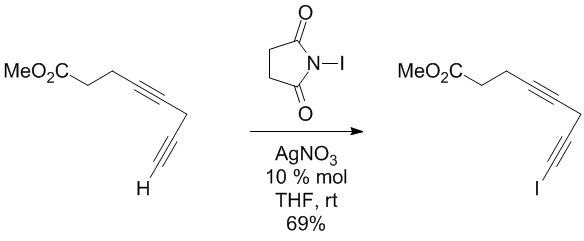To a cooled solution (–78 °C) of 8-bromoquinoline (2.25 g, 10.8 mmol) in THF (70 mL) in a flame-dried flask under N2 was added n-BuLi (2.5 M in hex, 6 mL, 15 mmol) drop-wise. The dark orange mixture was allowed to stir for 10 min. Aldehyde (2.84 g, 16.2 mmol, readily available from salicylaldehyde and 1-chloro-2-methyl-2-propene) was slowly delivered as a solution in THF (3 mL) over a span of 10 min to give a dark cloudy red solution. The reaction was stirred at –78 °C for 20 min, and allowed to warm to room temperature over 2 h. The clear orange solution was quenched with saturated NH4Cl (60 mL), and the layers were separated. The organic layer was washed with water (10 mL), and the combined aqueous washes were extracted with Et2O (2 x 50 mL). The combined organic portions were washed with brine (30 mL), dried over Na2SO4, and concentrated. The resulting orange-yellow residue was taken up in Et2O and a colorless precipitate formed. Collection of this precipitate by vacuum filtration gave the alcohol (1.80 g, 5.9 mmol, 55%), which was carried on directly. The intermediate alcohol (1.53 g, 5 mmol) was dissolved in DMSO (33 mL) and allowed to react with IBX (2.92 g, 10 mmol). The solution was maintained at room temperature for 2 h. Ethyl acetate (20 mL) and water (20 mL) were added, and the resulting colorless precipitate was removed by filtration through Celite. The layers were separated, and the aqueous portion was extracted with EtOAc (3 x 10 mL). The combined organics were washed with brine (20 mL), dried over Na2SO4, and concentrated. The yellow-orange oil was purified by column chromatography over silica gel (1:9 EtOAc:Hex) gave 1 as viscous yellow oil (1.20 g, 3.97 mmol, 79%, 43% over the two steps). Rf .23 (1:4 EtOAc:Hex)
1H NMR (300 MHz, CDCl3) δ 8.77 (dd, J = 1.8, 4.2 Hz, 1H), 8.13 (dd, J = 1.8, 8.4 Hz, 1H), 7.91 (dd, J = 1.8, 7.5 Hz, 1H), 7.81 (dd, J = 1.5,8.4 Hz, 1H), 7.78 (dd, J = 0.9, 6.6 Hz, 1H), 7.54 (app t, J = 7.8 Hz, 1H) 7.47-7.41 (m, 1H), 7.34 (dd, J = 4.2, 8.1 Hz, 1H), 7.05 (app t, J = 7.5, Hz, 1H), 6.81 (d, J = 8.1 Hz, 1H), 4.49-4.36 (m, 2H), 3.97 (s, 2H). 1.16 (s, 3H); 13C NMR (75 MHz, CDCl3) δ 196.8, 158.1, 150.3, 145.9, 141.6, 139.7, 135.7, 133.6, 131.2, 129.8, 129.5, 128.2, 128.0, 125.8, 121.2, 120.5, 112.6, 112.2, 72.0, 18.7; IR (thin film) 3078, 2915, 1645, 1595, 1573, 1485, 1451, 1322, 1294, 1246, 1158, 1109, 1040, 1006, 926, 907, 798, 754, 626; HRMS (ESI) calcd for [C20H17NO2 + H]+ 304.1332, found 304.1329.
A 0.2 M solution of 1 in PhMe was prepared in a N2 atmosphere glove box. RhCl(PPh3)3 (10 mg, 0.01 mmol) catalyst was carefully weighed into a 1 dram vial, and the solution of 1 (0.5 mL, 0.1 mmol) was added followed by toluene (0.5 mL). The vial was capped with a PTFE lined screw-cap and resulting yellow-orange solution was maintained at 130 °C for 48 h. The cloudy brown mixture was removed from the glove box and concentrated onto Celite. Column chromatography (EtOAc:Hex) gave 2 as colorless viscous oil (28.7 mg, 0.095 mmol, 96%). Rf 0.31 (1:4 EtOAc:Hex)
1H NMR (300 MHz, CDCl3) δ 8.94 (dd, J = 2.1, 4.5 Hz, 1H), 8.18 (dd, J = 1.8, 8.4 Hz, 1H), 7.91 (dd, J = 1.5, 8.4 Hz, 1H). 7.81 (dd, J = 1.8, 7.2 Hz, 1H), 7.56 (dd, J = 7.2, 8.1 Hz, 1H), 7.44 (dd, J = 4.2, 8.4 Hz, 1H), 7.13-7.07 (m, 2H), 6.83-6.78 (m, 2H), 4.72-4.55 (m, 2H), 3.97-3.75 (m, 2H), 1.55 (s, 3H); 13C NMR (125 MHz, CDCl3) δ 204.7, 159.1, 150.5, 145.5, 140.1, 136.3, 135.5, 131.2, 129.0, 128.23, 128.2, 126.1, 122.9, 121.5, 120.4, 109.7, 83.0, 54.2, 44.4, 25.9; IR (thin film), 3045, 2961 1681, 1595, 1568, 1479, 1346, 1247, 1216, 970, 831, 792, 750; HRMS (ESI) calcd for [C20H17NO2 + H]+ 304.1332, found 304.1337. The structure was confirmed by HMQC, COSY, and HMBC.



